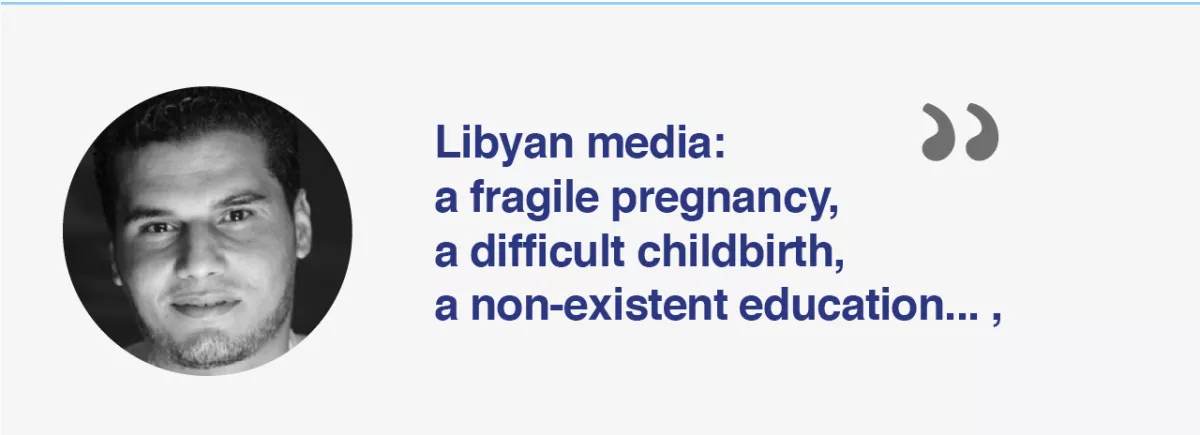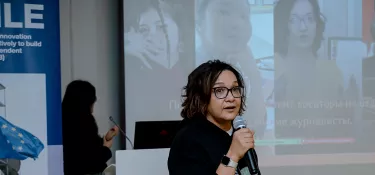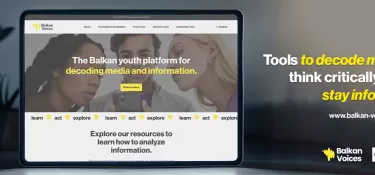
I am a Libyan journalist: Imad Hamed
Related project
HiwarThe words of Imad Hamed, director and presenter at Libya Rouhouha Al Watan TV in Amman, Jordan.
I am Imad Hamed.
Over the last twenty years, journalism and the media in Libya have gone through four very different stages, each of which has had consequences for journalists' work and the public's view of the media. This article describes these four stages of Libyan journalism for the reader.
Stage one: The media of the Jamahiriya
Stage one begins with Gaddafi's speech at Zuwara in April 1973, in which he proclaimed what he called the cultural revolution, annulled all the laws and declared the revolution of the people. After this speech, Gaddafi put hundreds of intellectuals and journalists behind bars. This had repercussions for journalism, which went from being state journalism to revolutionary journalism.
Seventy per cent of the news was centred on Gaddafi receiving visitors or visiting parts of the country; the rest was articles on the Revolutionary Council, which only talked about outside plots, the third universal theory and other pet topics of the presidential media at the time.
Libya's journalists were forced to choose between ideologically committed journalism, writing about art or sport, or finding another job.
Stage two: "The Libya of Tomorrow"
In early 2006, Saif al-Islam Gaddafi declared the start of a new stage in the history of the Jamahiriya: the Libya of Tomorrow. This saw the birth of new private media organisations which were meant from the start to enjoy wide freedoms. The same year, the newspapers Oea and Quryna newspapers appeared, as did the Al Shabab television channel and new radio stations.
The public was optimistic, and journalists felt free to write without interference. No one can deny that Libyan journalists enjoyed a lot of freedom from 2006-2010. Nevertheless, Saif Gaddafi had drawn some red lines that could not be crossed: it was forbidden to talk about Gaddafi, his sons and the people close to him, the "fat cats".
But let's talk about the freedoms.
For instance, newspapers in the Libya of Tomorrow tackled some subjects that had been previously been taboo, such as when the Quryna newspaper ran an inquiry into Abu Salim prison and its victims. On the other hand, Saif and his media were not able to talk about the executions on 7 April 1976, the death of Musa Al Sadr or other sensitive topics.
Stage three: The February media
When the Revolution erupted in February 2011, several new television channels and newspapers emerged, along with many new young journalists with no previous experience in the trade. This stage is extremely important in the modern history of Libya. It essentially marks the starting point of unlimited freedom of expression, with no observers censoring the opinions of others. The most important thing is that this period enabled journalists to unite in their narratives, to fight Gaddafi and put an end to his régime. This stage was short-lived, however, and gave way to the stage we are at now.
Stage four: Chaos in the media
In the last few years, the Libyan media scene has been occupied by a variety of TV channels and journalists. Some try to sell their ideology to the public, others work to undermine the credibility of their competitors. The majority abuse their power and try to brainwash people, cities and entire regions. Sadly, the media scene has transformed into a platform for partisan messages, each presenting a particular side as the country's best and most natural guardian.
Sadly, the Libyan media have lost the trust of the public, which is beginning to doubt their credibility.
Throughout these four stages, the Libyan media have always sought to transmit the rosiest image of whoever was in charge at the time. Sadly, they have never thought about how to grow.In order to sustain democratic debate in Libya, CFI launched Project Hiwar in early 2017 in partnership with the Crisis and Support Centre of the French Ministry of Europe and Foreign Affairs. The project creates a forum for the expression of different points of view on the Libyan press.
One session made up of four workshops was arranged in Tunisia. It was attended by twelve Libyan journalists, who travelled from Libya, Jordan, Turkey, Egypt and Tunisia.
This article forms part of the booklet I am a Libyan journalist, which collects a variety of pieces written by the journalists involved in Project Hiwar.



